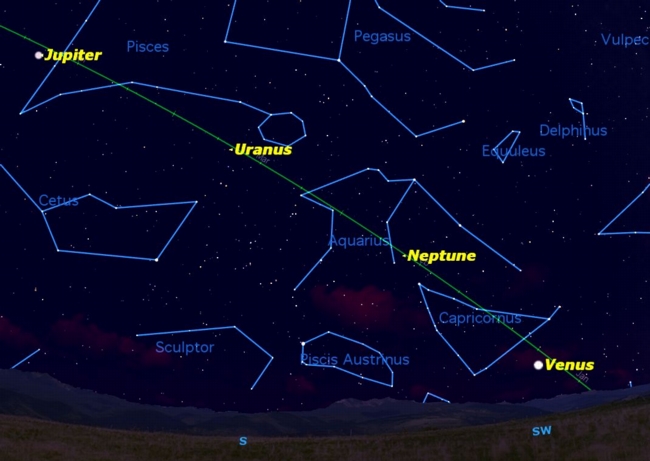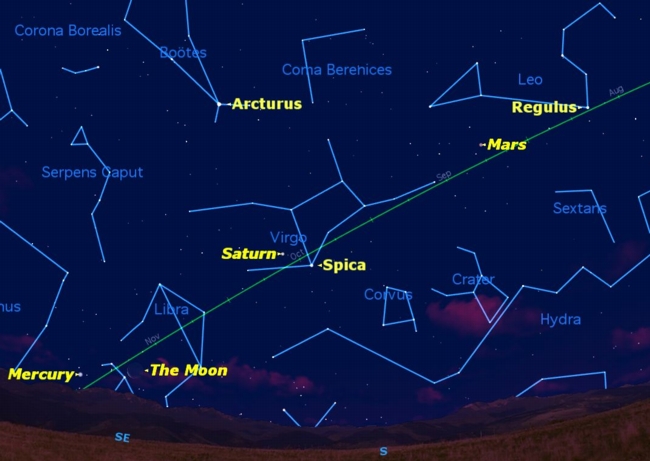Rare Sight! See All 7 Planets in the Night Sky This Week

This week presents a rare opportunity to see all the major planets of the solar system in a single night.
Just after sunset tonight (Dec. 21) the two brightest planets will be shining, weather permitting. Venus, the brightest, rides low in the southwest just above the setting sun. Jupiter, the second brightest planet, is high in the south.
If you have a telescope, you can find Uranus and Neptune between Venus and Jupiter. The sloping line across the sky that the four planets define is called the ecliptic, because it is the line along which eclipses take place.
The sky maps of the planets available here show where to look to try to spot them this week.
Get up around 6 a.m. local time tomorrow morning, and you can see the rest of the planets. The ecliptic is now sloping in the opposite direction, and along it are arrayed Mercury, the moon, Saturn, and Mars. In the background are three of the brightest stars in the sky: Arcturus, Regulus, and Spica. [Photo Tour of the Solar System's Planets]
Pay particular attention to Spica because, over the next year, the moon will make numerous close passes near Spica, actually passing in front of the star and occulting it on a few occasions. Such close approaches between astronomical objects are called conjunctions. While not of much importance to modern astronomers, they are always interesting to observe.

Tonight's array of the planets is the opposite of a conjunction. None of the planets are particularly near each other.
Get the Space.com Newsletter
Breaking space news, the latest updates on rocket launches, skywatching events and more!
What makes this event special is that the planets are almost equally spaced around the ecliptic, the only large gap being between Mars and Jupiter, 135 degrees. Your closed fist held at arm's length covers about 10 degrees of the night sky.
The only time you can see both Mars and Jupiter tonight is around midnight. Jupiter will be setting in the west just as Mars is rising in the east.
So, try to get out there tonight and see how many of the planets you can see.
Uranus and Neptune will be difficult in the evening, because they are faint and require a telescope. Mercury will be difficult in the morning because it will be close to the rising sun, but use the thin crescent moon as a guide to its location.
If you're clouded out tonight, keep trying over the next week, as the planets don't move very quickly.
One planet might get overlooked: the Earth. After you've looked at the seven major planets in the sky, don't forget to look down at your feet and see your home planet.
If you snap a stunning photo of the planets tonight and would like to share the experience with SPACE.com, send images or comments to Managing Editor Tariq Malik at: tmalik@space.com.
This article was provided to SPACE.com by Starry Night Education, the leader in space science curriculum solutions. Follow Starry Night on Twitter @StarryNightEdu.
Join our Space Forums to keep talking space on the latest missions, night sky and more! And if you have a news tip, correction or comment, let us know at: community@space.com.

Geoff Gaherty was Space.com's Night Sky columnist and in partnership with Starry Night software and a dedicated amateur astronomer who sought to share the wonders of the night sky with the world. Based in Canada, Geoff studied mathematics and physics at McGill University and earned a Ph.D. in anthropology from the University of Toronto, all while pursuing a passion for the night sky and serving as an astronomy communicator. He credited a partial solar eclipse observed in 1946 (at age 5) and his 1957 sighting of the Comet Arend-Roland as a teenager for sparking his interest in amateur astronomy. In 2008, Geoff won the Chant Medal from the Royal Astronomical Society of Canada, an award given to a Canadian amateur astronomer in recognition of their lifetime achievements. Sadly, Geoff passed away July 7, 2016 due to complications from a kidney transplant, but his legacy continues at Starry Night.










